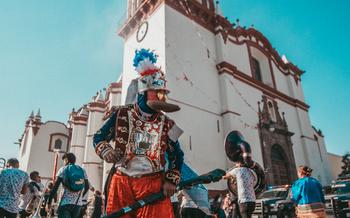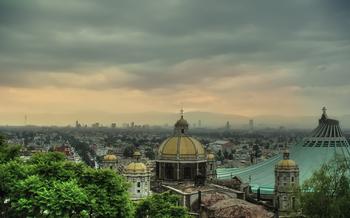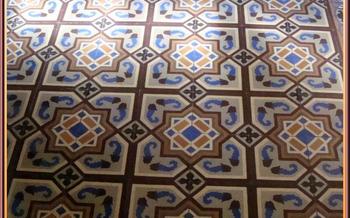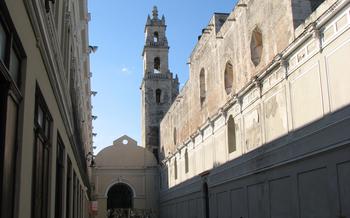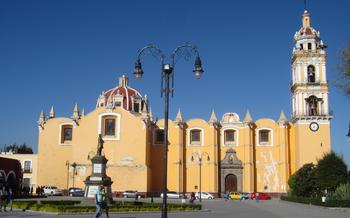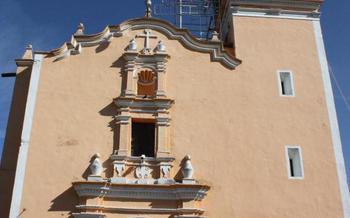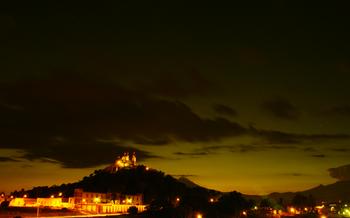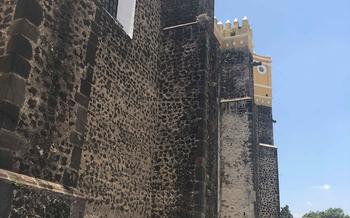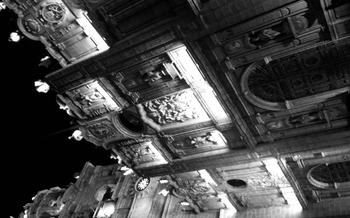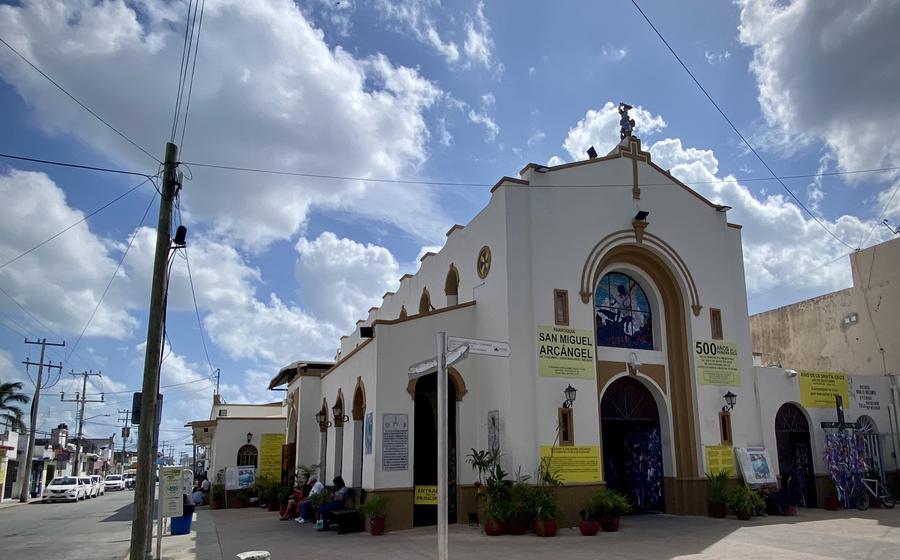
San Miguel Church (Iglesia de San Miguel)
- Year of Construction, Architectural Style, and Historical Context
- Location of the San Miguel Church
- Opening Hours and Fees
- Exterior of the San Miguel Church
- Interior of the San Miguel Church
- Religious Services and Events
- History of the Patron Saint
- The Cultural Significance of the San Miguel Church
- Restoration and Preservation Efforts
- The Role of the San Miguel Church in Tourism
- Personal Anecdote or Experience
- Local Festivals and Celebrations
- Tips for Planning Your Visit
Year of Construction, Architectural Style, and Historical Context
The San Miguel Church, a majestic edifice in the heart of Cozumel, stands as a testament to the island's rich history and deep-rooted Catholic faith. Constructed in the late 17th century, around 1650, it boasts an architectural style that blends elements of Spanish colonial and Baroque aesthetics. During this period, Cozumel was a strategic location for Spanish trade routes, and the church served as a spiritual sanctuary for sailors, merchants, and settlers seeking solace and guidance. Its construction coincided with the rise of Catholicism in Mexico, and the church played a pivotal role in spreading the faith and establishing religious traditions that continue to shape the cultural identity of Cozumel.
Location of the San Miguel Church
The San Miguel Church, a beacon of faith and spirituality, stands as a proud symbol of Cozumel's rich cultural heritage. Located in the heart of San Miguel de Cozumel, the capital of the island, the church is easily accessible to visitors. Its exact address is Calle 2 Norte, between Avenidas 5 and
Reaching the San Miguel Church is a delightful journey that immerses you in the vibrant local culture. To get there, you can take a leisurely stroll through the charming streets, adorned with colorful buildings and friendly faces. Alternatively, you can hop on a local bus or rent a bicycle to explore the town's many attractions.
Surrounding the church, visitors can discover a treasure trove of historical and cultural landmarks. The main square, Plaza del Sol, is just a stone's throw away, where you can soak in the lively ambiance and admire the iconic clock tower. Within walking distance, you'll find the Cozumel Museum, showcasing the island's fascinating history and cultural heritage.
Safety is paramount in Cozumel, and the area surrounding the San Miguel Church is generally considered safe for tourists. However, as with any destination, it's always advisable to exercise caution and be aware of your surroundings.
Opening Hours and Fees
The San Miguel Church is open to the public daily from 8:00 am to 6:00 pm. Admission to the church is free of charge, making it accessible to visitors from all socioeconomic backgrounds. Guided tours are available upon request and are conducted by knowledgeable local guides who can provide historical insights and anecdotes.
The best time to visit the San Miguel Church is during the morning when the sunlight illuminates the intricate details of the church's exterior and interior. Visitors can avoid the crowds and fully immerse themselves in the spiritual atmosphere of the church during this time.
Exterior of the San Miguel Church
The exterior of the San Miguel Church is a testament to the architectural prowess of the Spanish colonial era. Its majestic façade, crafted from warm-hued stone, features intricate carvings and decorative elements that blend Renaissance and Baroque styles. The imposing bell tower, a prominent landmark, rises skyward, its arches and finials reaching for the heavens.
The church's main entrance, adorned with an ornate architrave, welcomes visitors into its sacred space. Above the entrance, a niche houses a statue of San Miguel Arcángel, the church's patron saint, depicted in his iconic battle against the forces of evil. The church's exterior walls are adorned with a series of buttresses, providing both structural support and visual interest. These buttresses are adorned with niches housing statues of various saints, each with their own unique iconography and symbolism.
The overall effect of the San Miguel Church's exterior is one of grandeur and awe-inspiring beauty. Its intricate details, harmonious proportions, and the use of natural materials create a masterpiece that stands as a testament to the enduring legacy of Spanish colonial architecture in Mexico.
Interior of the San Miguel Church
Step through the grand entrance of the San Miguel Church, and you will be greeted by an awe-inspiring display of religious art and architecture. The interior of the church is a testament to the skill and devotion of the artisans who created it.
The main altar is an elaborate affair, adorned with intricate carvings, gold leaf, and colorful paintings. It is the focal point of the church, where the priest conducts Mass and other religious ceremonies.
The walls are lined with stunning stained glass windows, each depicting a different scene from the Bible. The windows fill the church with a warm, colorful light, creating a truly ethereal atmosphere.
The ceiling is adorned with beautiful murals, depicting the life of Jesus Christ and the saints. The murals are a testament to the artistic talent of the local artisans who created them.
The interior of the San Miguel Church is a true work of art, and it is easy to see why it is considered one of the most beautiful churches in Cozumel. It is a place of peace and tranquility, where visitors can come to pray, reflect, and appreciate the beauty of God's creation.
Religious Services and Events
The San Miguel Church is the heart of the Catholic community in Cozumel, and it regularly holds religious services and events that attract locals and visitors alike.
Regular Mass Schedules
Masses are held daily in Spanish, with the main service taking place on Sundays at 10 am. During these services, the church's interior transforms into a vibrant space of prayer and devotion, where the community comes together to celebrate their faith.
Special Events and Festivals
Throughout the year, the San Miguel Church hosts a variety of special events and festivals that draw large crowds. One of the most significant celebrations is the annual feast day of San Miguel Arcángel, which takes place on September 29th. During this festival, the church is adorned with colorful decorations, and a grand procession honoring the patron saint winds its way through the streets of Cozumel.
Traditions and Customs Observed
During religious services and events, certain traditions and customs are observed within the San Miguel Church. Visitors are encouraged to dress respectfully and maintain a quiet and contemplative atmosphere. It is customary to stand during the Gospel reading and kneel during the consecration of the Eucharist.
Dress Code and Etiquette
To show respect for the sacred nature of the church, visitors are expected to dress modestly and appropriately. Shorts, tank tops, and revealing clothing are generally discouraged. When entering the church, it is customary to remove your hat and make the sign of the cross.
History of the Patron Saint
**Who is San Miguel Arcáng Archangel, is a revered figure in Christianity and is considered one of the seven archangels mentioned in the Bible. He is renowned for his role as the leader of the heavenly army and is often depicted as a warrior angel defeating the forces of evil.
Patronage and significance
In Cozumel, San Miguel Arcángel is the patron saint of the city. He is revered for his protection and guidance, and his image can be found in many homes, businesses, and public spaces across the island. The people of Cozumel believe that San Miguel watches over them and intercedes on their behalf, bringing them peace, prosperity, and spiritual well-being.
Local legends and stories
There are many local legends and stories surrounding San Miguel Arcángel in Cozumel. One popular tale tells of how San Miguel appeared to a group of fishermen during a violent storm, calming the raging waters and guiding them safely to shore. Another story recounts how San Miguel intervened to protect the island from a devastating hurricane, averting disaster and saving countless lives.
Cultural importance in Cozumel
San Miguel Arcángel holds a special place in the hearts of the people of Cozumel. His image is a symbol of faith, hope, and protection, and his feast day, celebrated on September 29th, is one of the most important religious holidays on the island. During this time, the community comes together to honor San Miguel with processions, masses, and other festivities, expressing their gratitude and devotion to their beloved patron saint.
The Cultural Significance of the San Miguel Church
The San Miguel Church holds immense cultural significance for the people of Cozumel. It stands as a testament to the deep-rooted Catholic faith that permeates the community, serving as a spiritual anchor and a symbol of religious devotion. The church's grandeur and historical relevance make it an intrinsic part of the local identity, deeply interwoven with the traditions and customs of Cozumel's inhabitants.
Throughout the years, the San Miguel Church has played a pivotal role in shaping the cultural fabric of the island. It has served as a gathering place for religious celebrations, community events, and social interactions, fostering a sense of unity and belonging among the residents. The church's presence has influenced local customs and traditions, such as the annual festivities honoring San Miguel Arcángel, which draw participants from all corners of Cozumel to celebrate their patron saint with vibrant processions, traditional dances, and heartfelt prayers.
The San Miguel Church also contributes to the preservation of Cozumel's cultural heritage. Through its enduring presence, it serves as a reminder of the island's rich history and the unwavering faith of its people. The church's architecture, artwork, and religious artifacts offer a glimpse into the past, providing a tangible connection to the island's cultural legacy. By safeguarding this sacred space, the community ensures that future generations can continue to appreciate and learn from its cultural significance.
Restoration and Preservation Efforts
Throughout its existence, the San Miguel Church has undergone various restoration and preservation efforts to maintain its structural integrity and historical significance. In the early 20th century, the church underwent a major renovation that involved repairs to the roof, walls, and interior decoration. This restoration aimed to preserve the church's original architectural features and prevent further deterioration.
In recent years, there has been a renewed focus on preserving the San Miguel Church as a cultural heritage site. The local community has played a vital role in these efforts, working alongside government agencies and private organizations to secure funding and expertise for restoration projects. These projects have included the restoration of the church's interior murals, the installation of new lighting systems, and the repair of damaged stained glass windows.
One of the biggest challenges faced by the restoration team was the deterioration of the church's exterior stonework. Over time, the harsh coastal environment had caused significant damage to the stone, resulting in cracks, erosion, and loss of detail. To address this issue, experts employed specialized techniques to clean and repair the stonework while preserving its original appearance.
The restoration and preservation efforts at the San Miguel Church are ongoing, ensuring that this iconic landmark continues to stand as a testament to the faith, history, and cultural heritage of Cozumel. By working together, the local community and various stakeholders are committed to preserving the church for future generations to appreciate and enjoy.
The Role of the San Miguel Church in Tourism
The San Miguel Church holds a significant position in the tourism landscape of Cozumel. Its historical allure, cultural significance, and architectural beauty have made it a popular attraction among visitors from around the world. Here's how the church contributes to the local tourism industry:
Cultural Heritage Magnet:
- The San Miguel Church serves as a repository of Cozumel's rich cultural heritage. It embodies the island's religious traditions, artistic expressions, and historical legacy. Visitors are drawn to this sacred space to learn about and experience the island's cultural tapestry.
Local Economy Contributor:
- The church's status as a tourist attraction also contributes to the local economy. Visitors who come to see the church often spend money on transportation, food, souvenirs, and other services, thereby supporting local businesses and generating revenue for the community.
Promotion of Cultural Heritage:
- The San Miguel Church plays a crucial role in promoting Cozumel's cultural heritage on a global scale. Through guided tours, historical exhibitions, and online platforms, the church showcases its unique features and significance to visitors from different parts of the world.
Responsible Tourism Practices:
- The church's management and local authorities work together to ensure responsible tourism practices. They promote ethical behavior, respect for the sacred space, and the preservation of the church's cultural and historical integrity.
By embracing its role in tourism, the San Miguel Church contributes to the preservation and promotion of Cozumel's cultural heritage while fostering economic growth and responsible tourism practices.
Personal Anecdote or Experience
One afternoon, during my explorations of San Miguel's interior, I found myself drawn to a small, unassuming side altar. It was dedicated to the Virgin Mary, and as I approached, I noticed a group of women gathered in prayer. I hesitated, unsure of whether I should interrupt their private moment. But then, one of the women smiled and gestured for me to join them.
I knelt beside them and closed my eyes, feeling a sense of peace and reverence. As the women prayed, I couldn't help but be moved by their devotion. I thought about how this church had stood for centuries, bearing witness to countless prayers and petitions. It was a place where people came to seek solace, to give thanks, and to connect with their faith.
After the prayers, I thanked the women for welcoming me. They smiled and told me that I was always welcome in their church. I left San Miguel that day with a renewed sense of appreciation for the power of faith and the importance of community.
Local Festivals and Celebrations
The San Miguel Church is not only a place of worship but also a focal point for cultural celebrations in Cozumel. Each year, the church hosts several festivals and events honoring San Miguel Arcángel, the patron saint of the island. These events are a vibrant display of local traditions, music, and dance.
The most prominent celebration is the annual San Miguel Arcángel Festival, held on September 29th. The festivities begin with a solemn mass followed by a colorful procession. Devotees carry the statue of San Miguel through the streets of Cozumel, accompanied by music and dancing. The procession ends with a blessing at the church, where a grand fiesta takes place.
Other notable events include the Feast of the Holy Cross in May, which celebrates the finding of the True Cross by Saint Helena. The Feast of the Assumption of Mary in August, which honors the Virgin Mary's ascent into heaven. During these festivals, the church is decorated with flowers, and special masses are held to honor the saints.
These celebrations are an excellent opportunity for visitors to immerse themselves in the local culture and traditions of Cozumel. By participating in the festivities, visitors can experience the vibrant energy and devotion that surrounds the San Miguel Church.
Tips for Planning Your Visit
When visiting the San Miguel Church, it's essential to be mindful of the cultural and religious significance of the site. Appropriate attire is recommended, such as modest clothing that covers the shoulders and knees. Photography is generally allowed, but it's important to be respectful and avoid using flash or disturbing ongoing services. Respectful behavior is expected, including maintaining a quiet and reverent demeanor. Plan to allow ample time to explore the church, as there's much to see and appreciate, such as its architecture, artwork, and religious artifacts.
